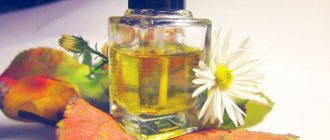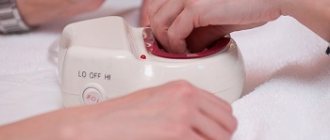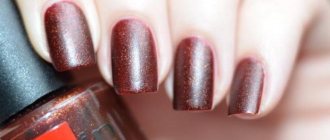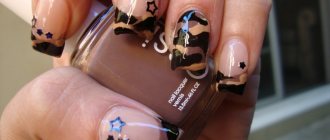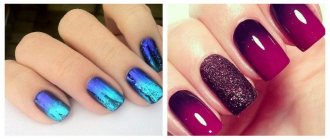Negative environmental factors, diseases, stress, poor diet, frequent extensions, and the use of low-quality nail polishes and nail polish removers immediately affect the condition of the nails and cuticles. The nail plate becomes dull and lifeless, the cuticle takes on an unhealthy appearance.
The appearance of these symptoms causes an immediate desire to help the nails and give them vitality. Beauty salon specialists can help solve the problem and offer a course of restorative and caring procedures. The effect of using professional procedures will not be long in coming (that’s why it’s professional cosmetics), but using home remedies for nails turns out to be no worse. You just need to learn to allocate a few minutes a day for yourself to your loved one. And your hands will thank you.
Today it is much easier for modern fashionistas to take care of themselves and, in particular, their hands. After all, the arsenal of care products can be replenished with both professional products and time-tested nourishing masks and essential and vegetable oils.
Vegetable and essential oils for beautiful nails
Vegetable and essential oils are popular hand care products. They have a number of useful properties and contain a complex of vitamins and microelements necessary to maintain healthy nails and improve their health.
The following oils have a beneficial effect on nails and cuticles:
- tea tree oil,
- olive,
- burdock,
- castor,
- linseed oil,
- lemon ether,
- almond,
- nutty,
- jojoba oil,
- ylang-ylang,
- Irish rose oil.
Tea tree oil
Tea tree oil is an excellent antibacterial agent that helps fight fungal diseases of the fingernails and toenails.
Tea tree oil may cause an allergic reaction, so consult a healthcare professional before using it.
Olive oil
Olive oil is one of the most popular nail care products. It contains vitamins A and E, which are essential for nourishing nails. Olive oil improves the color of the nail plate, strengthens their structure and makes them less brittle.
Burr oil
Burdock oil is a real storehouse of vitamins, calcium, zinc, proteins and tannins. It stimulates nail growth, helps strengthen them, prevents brittleness and splitting of the nail plate, and restores nails after extension procedures. To obtain the desired effect, it is enough to rub the oil on unvarnished nails once or twice.
Castor oil
For decades, castor oil has been helping to care for nails.
Castor oil is an inexpensive but very effective remedy that strengthens nails, gives them shine, and also has a beneficial effect on the cuticle and softens hangnails.
Linseed oil
Flaxseed oil promotes regeneration and strengthening of the nail plate. Baths with linseed oil nourish the skin of your hands, making it velvety, and strengthen your nails.
Lemon ether
If you used a low-quality polish that darkened your nails, use lemon ether (or lemon oil). It nourishes nails well without drying them out, brightens the surface of the nail plate, softens hangnails and cuticles.
Lemon ether does not dry out nails like lemon juice, so it is recommended for daily use.
Almond oil
Almond oil strengthens nails, prevents their splitting, and softens the skin. Useful for baths.
Peanut butter
A very healthy nut oil, rich in iodine and vitamin E, which helps strengthen and grow nails. After using nut oil, due to its high iodine content, your nails may darken slightly. Therefore, it is best to apply it at night. The effect of dark nails after applying the oil quickly disappears.
Jojoba oil
Jojoba oil is called liquid wax, as it forms a protective layer on the nails, promotes the regeneration of the nail plate, removes harmful substances, improves the color of the nails, and has a good effect on the cuticle. An additional advantage of jojoba oil is its long shelf life, which preserves all the beneficial substances.
Ylang-ylang oil
Ylang-ylang oil prevents nail splitting, accelerates their growth, and protects against bacteria and fungus. Usually used with transport (base) oil.
Irish rose oil
Irish rose oil strengthens and moisturizes nails, so it is recommended after drying nails with ultraviolet radiation (under a lamp or sunlight). Can be used daily.
It is also often used to improve the appearance and condition of nails.
- sunflower oil,
- orange oil,
- Peach oil,
- Coconut oil,
- apricot oil,
- celandine oil,
- wheat germ oil.
They are used both in pure form, lubricating the nails and rubbing them into the nail plate, and in the form of compresses and baths.
Hand cream and nail oil
The composition of the hand and nail cream is designed to penetrate beneficial microelements into the skin of the hands and the structure of the nail plate, so adding oil to the cream will facilitate the rapid “delivery” of the necessary vitamins. Sometimes oils are dripped into your favorite cream to get an additional effect (antibacterial or whitening).
Natural components of oils easily interact with the capabilities of creams . You can add essential oils to not only strengthen your nails, but also enhance the aroma of the cream. Oil-based nail care allows you to carry out fairly effective and inexpensive procedures at home, and the results will pleasantly amaze you.
Nail and cuticle care
Salt has an excellent strengthening effect. Dilute 2-3 tbsp. spoons in 1 liter of warm water and hold your nails for 10-15 minutes. After the bath, lubricate your nails with your favorite oil and let it absorb.
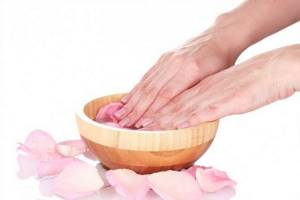
Baths with salt perfectly strengthen nails.
Are you worried about skin inflammation and dry cuticles? To treat them, take 3 drops of tea tree oil, 3 drops of lavender oil and 15 drops of any vegetable oil (almond, apricot, peach, etc.). Lubricate your nails and cuticles. Repeat the procedure several times.
Also pamper your nails with the following treatment composition. For it, take 3 drops of tea tree oil, 5 drops of coconut oil, 5 drops of peach oil, 3 drops of lavender oil and 1 capsule of vitamin E. Mix all the ingredients and rub the resulting mixture into your nails. This remedy acts against minor inflammations, strengthens nails, and helps them grow.
2 tbsp will help give your nails a glossy look. spoons of jojoba oil, 3 drops of rose oil, 3 drops of lemon oil, 2 drops of eucalyptus oil.
The double action effect - simultaneous care of nails and hands - can be achieved using the following ingredients:
- 2 drops almond oil,
- 2 drops avocado oil,
- 2 drops of lemon oil.
The results of this product will be noticeable with daily use.
ESSENTIAL OILS FOR NAIL FUNGUS: PRINCIPLE OF OPERATION

A significant advantage of treating nail fungus with essential oils is their complex effect. Oils contribute to:
• healing of wounds and microcracks,
• prevention of re-infection,
• preventing infection of healthy tissues,
• eliminating unpleasant odors,
• relieving inflammation and swelling,
• relief from pain, itching and burning.
Essential oils for nail fungus act quickly and noticeably cool the nail plate after application. Their influence makes it possible to effectively cure the disease and, moreover, to minimize its unpleasant manifestations during therapy.
It takes several months for complete recovery from the fungus. Treatment should be continued until the healthy nail grows back. At the end of the course, it is best to do preventive procedures to avoid relapse.
Almost all essential oils for nail fungus have a pronounced antiseptic effect. They are active in both external and deep layers.
However, it should be remembered that it is difficult to completely get rid of fungus using essential oils alone. Fungal infections are best treated in combination with local pharmaceutical medications.
Useful tips
Use nail oils either alone or in combination with scrub and hand peeling.
Periodically pamper your nails with nourishing compresses. To do this, moisten your nails with the chosen product (oil or a mixture of oils), cover with cotton pads and insulate them with a towel on top. Keep the compress for 20 minutes.
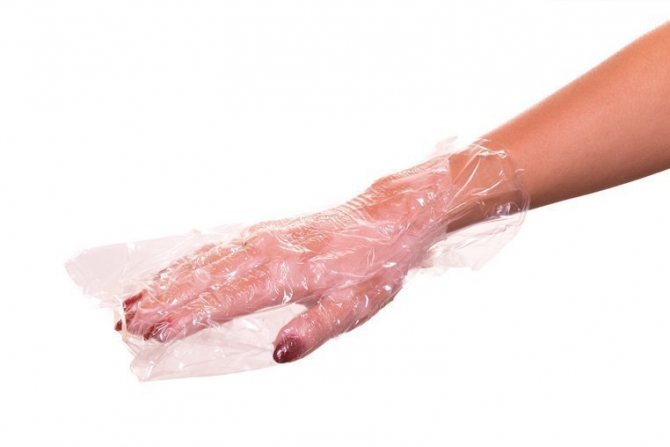
For cosmetic procedures, use cotton or polyethylene gloves.
To avoid contact of hands and nails with water and other products (when washing dishes, laundry, makeup), perform the procedures before going to bed.
RULES FOR USE OF ESSENTIAL OILS FOR FUNGUS NOTES
After choosing the right essential oil, the first thing you need to do is test for an allergic reaction. To do this, you need to apply a few drops of essential oil to your wrist or inner surface of the elbow and monitor the body's reaction. If after some time there is no itching or redness, then the oil can be safely used.
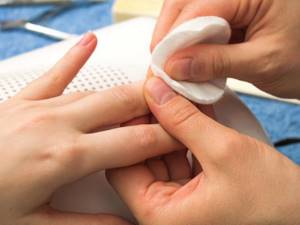
When using essential oils for nail fungus, you should follow a number of rules:
1. Before applying essential oil to the affected area, it should be diluted with a carrier oil. The mixture must be rubbed not only into the nail plate, but also into the skin around it;
2. When using essential oils in the form of applications, to achieve the best effect, you can make a mixture of different essential oils in equal proportions. A tampon or cotton pad soaked in the prepared mixture is applied to the affected area and secured with a bandage or adhesive tape;
3. To increase the effectiveness of treatment, you must first steam your nails in a bath using tar soap or soda. Adding a few drops of essential oil to the bath will also have a beneficial effect on the health of your nails.
How to use oil
Before use, you need to carefully prepare the epidermis. The product should be applied both before the manicure (softening) and after it (regenerating). Before doing this, you need to steam your fingers and wash your hands well. It is also important to lightly file the cuticle - for this, use a special soft file or a flat buff. This will remove the rough epidermis and prepare it for further processing.

Using cuticle oil
Step-by-step instructions for using cuticle oil from Famous Names Dadi'Oil:
- The aromatic agent spreads evenly over the entire plane of the epidermis;
- The product must be applied not only to the cuticle, but also to the nail bed. If you just smear it on the epidermis, there will be no effect. You need to lightly massage the area where the product is applied - this will speed up the metabolism;
- Then you need to wait a few minutes. If the procedure is done before a manicure session, then the oil is kept for 5 minutes. If after it, then leave it for 20 minutes (longer if possible);
- When the time is up, the product is simply wiped off with a simple napkin.
You need to use the product every day. Any manicurist will tell you that the durability and accuracy of the manicure depends on the condition of the cuticle.
Consequences
This seemingly harmless disease can have very serious complications:
- damage to smooth skin and secondary infection;
- fungal sensitization with the formation of allergic reactions and foci of microbial eczema;
- complication of chronic dermatoses, varicose veins of the lower extremities and foot lesions in diabetes mellitus, etc.
It is impossible not to mention the epidemiological significance of existing foci of fungal infection: a sick person will infect public places and other people, and in everyday life will be a source of intra-family transmission of fungal infection.
Olive oil

Strengthening nails
Olive oil for nails is also extremely effective. It, like castor oil, is highly accessible and quite low in price. For cosmetic and manicure purposes, you can use simple food-grade purified olive oil, which is sold in supermarkets. It is an indispensable basis for many baths and masks, such as the one described in the previous part of the article.
But this oil works well on its own. It can and should be massaged into the plates every day before going to bed, and then put on cotton gloves. Every two to three days, you can add a few drops of lemon juice to this mask for a night compress, which is also extremely beneficial for the plates.
Composition of tea tree oil
The tea tree is a low shrub or small tree belonging to the myrtle family (Myrtaceae). There are many varieties of tea tree, but only Melaleuca alternifolia has significant therapeutic properties.
Tea tree essential oil is obtained from the leaves and branches of the tea tree by distillation. Tea tree oil contains:
- alpha-pinene,
- alpha-terpinene,
- limonene,
- para-cymene,
- cineol-1.8,
- gamma terpineol,
- terpinolene,
- terpene-4-ol,
- alpha-terpineol, etc.
Most "therapeutic grade" tea tree oils contain about 3% cineole, with terpene-4-ol contents of 35% or more. . This will be an original oil with optimal bactericidal properties, but minimal risk of irritation.
Tea tree essential oil is a natural topical remedy with a wide range of effects. It has antiseptic, antifungal, antiviral, anti-inflammatory, regenerating and immunostimulating effects.

What does a tea tree look like, photo
The oil effectively inhibits the growth of bacteria such as staphylococci, streptococci, pneumococci, gonococci, E. coli and a number of others, as well as fungal flora. The disinfecting properties of the oil are used in medicine, hygiene, and cosmetology.
The oil helps eliminate acne, warts, papillomas, dandruff, fungal skin infections, and is effective against insect bites, abrasions, and cuts. Strengthens hair follicles, which improves hair growth and structure.
It has a calming aromatherapy effect, helps restore the body after stress, relieves anxiety, and promotes concentration. The aroma imparts reasonable determination, preventing panic and hysteria.
So, tea tree oil is a unique, powerful natural antiseptic that is able to overcome even antibiotic-resistant pathogens. The compounds it contains are harmful to staphylococcus and streptococcus, as well as fungal and viral infections.
How to use tea tree oil for nails
Tea tree oil can be used in several ways:
- diluted for rubbing;
- in its pure form for massage;
- as the main component for lotions or compresses;
- for making ointment;
- as an additive to medicinal baths;
- for the production of antimicrobial socks.
Rubbing in diluted form
Most often, the drug to combat fungal infections is used in diluted form. This allows you to reduce the concentration of active substances in the composition and minimize the risk of side effects.
You can prepare the mixture in the following way:
- The basis is unrefined olive, coconut or other vegetable oil.
- Tea tree oil is added to it in a 2:1 ratio. You can take a standard recipe in which olive oil, thyme and tea tree oil are mixed in proportions of 2:1:1.
- The resulting mixture should be applied liberally to the nails and the skin around them using a cotton swab or cotton pad.
- The applied product is rubbed in using a special pedicure brush with massage movements until it is completely absorbed.
- 15–20 minutes after grouting, you need to apply an adhesive plaster or a tight bandage.
Important! The procedure is carried out twice every day (including at night).
Rubbing in its purest form
In its pure form, the oil is used only for chronic types of the disease, as well as in advanced cases:
- Apply 2 drops of undiluted tea tree oil to each nail. It is best to apply the product with a pipette.
- The composition is rubbed into the nail using a swab or cotton swab. It is not recommended to go on skin.
- After grouting, wait 8-10 minutes and then apply a bandage or tape over your nails.
The procedure is carried out twice a day, the last one is done before going to bed.
Compresses
It is also recommended to use melaleuca oil as a component for lotions in advanced cases:
- Undiluted ether is applied to a cotton swab, which, in turn, is applied to the affected nail plates for 10–15 minutes. The product must not come into contact with the skin.
- After removing the compress, do not wash off the product.
- You need to carry out the procedure twice a day, the second one before bedtime.
Ointment
To prepare an ointment based on tea tree oil, you will need an antifungal ointment prescribed by your doctor:
- The antifungal cream is squeezed out of the packaging onto a saucer.
- Add 1-2 drops of melaleuca extract to it.
- The finished mixture should be applied with massage movements into the nail and the skin around it.
This external treatment option is most often prescribed by mycologists. It is considered more effective than using a cream or essential composition in its pure form.
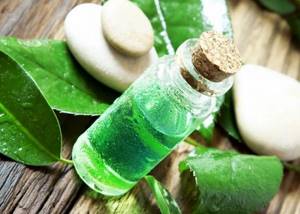
Essential baths
Baths not only have a disinfecting effect, they also soften tissues and accelerate the absorption of medicinal antifungal drugs. So it is best to carry out such procedures before applying the main treatments:
- Heat 2 liters of clean water to 45 degrees.
- Add 10-12 drops of tea tree ether to them. If you have the desire and opportunity, you can add an additional 1 tbsp to the mixture. a spoonful of sea salt and 2 tbsp. tablespoons of soda, 1 teaspoon of hydrogen peroxide and the juice of 1 lemon, or only 4 teaspoons of liquid soap.
- Immerse your feet completely in the solution and steam for 15–20 minutes.
- After steaming, remove the keratinized layer of nails with a file, wipe your feet dry and treat the nail plates with antifungal ointment and/or melaleuca oil.
Important! Such baths are recommended to be carried out once a week, but daily use is also allowed.
Antibacterial socks
The method works well as a preventive measure against re-infection:
- Take any clean cotton socks.
- Spray them with melaleuca ether to cover a large area.
- Ready socks should be worn over clean ones at night.
- Rinse your feet in cool water in the morning.
Sunflower oil

Nail oils
Another effective and very affordable product from your local supermarket is sunflower oil for nails. It is mainly used as a base or base oil for various masks and baths. Due to its rather unpleasant and recognizable smell, using it in its pure form may not be very comfortable. In addition, since it is quite greasy, even after quite a long time after application, your fingers can leave greasy marks on the surface and papers.

Essential oils to strengthen nails
However, it is indispensable in baths. So, to a teaspoon of this oil you can add a couple of drops of sage, chamomile and lavender oils. Lavender can be replaced with lemon oil in the same proportion or double the volume of eucalyptus oil. You can add 4 drops of sage, lavender and eucalyptus oils to the oil. Such components not only increase the effectiveness of each other as a whole, but also fight off the unpleasant odor of sunflower oil.


